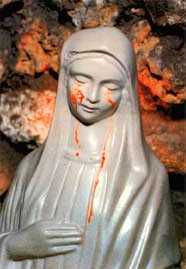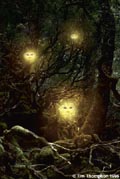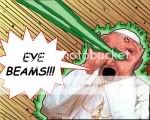Miracle Whip

Exploring the Science of Miracles
from The Washington Post
PAVIA, Italy - Such is the supply of miracles in Italy that if a month goes by without one, it's, well, a miracle.
Weeping
 Madonnas, sacred blood that goes from solid to liquid and back again, lottery numbers divined by gazing on a photo of a deceased pope, sudden cures after contact with a holy relic: Miracles are old, old phenomena in Italy, the land where Saint Francis tamed a wolf and wild doves and a veil taken from Saint Agatha's tomb stopped lava in its tracks.
Madonnas, sacred blood that goes from solid to liquid and back again, lottery numbers divined by gazing on a photo of a deceased pope, sudden cures after contact with a holy relic: Miracles are old, old phenomena in Italy, the land where Saint Francis tamed a wolf and wild doves and a veil taken from Saint Agatha's tomb stopped lava in its tracks.But this is also the land of science par excellence, the home ground of Galileo, da Vinci, Fermi, and Marconi. So there are also voices that say, "Hold on a minute."
Luigi Garlaschelli is a chemist who from his perch at Pavia University skeptically eyes Italy's parade of miracles. He belongs to a group called the Italian Committee to Investigate Claims of the Paranormal, made up of Italian scientists, including two Nobel Prize winners, who use science to try to explain the inexplicable.
"Miracles are just paranormal events in religious clothing," he says. "I'm a chemist. I look for the substance behind things." He's not trying to undermine people's religious beliefs, he says, explaining: "We're just trying to study phenomena. If there's a non-miraculous answer, we say so."
These
 days, he contends, it is more and more important to champion scientific methods in the face of assaults from religious authorities and fundamentalist believers. The attack on Charles Darwin's theory of evolution in the United States by promoters of a rival explanation known as intelligent design is a symptom of the danger, he said. "Science should not be lethargic."
days, he contends, it is more and more important to champion scientific methods in the face of assaults from religious authorities and fundamentalist believers. The attack on Charles Darwin's theory of evolution in the United States by promoters of a rival explanation known as intelligent design is a symptom of the danger, he said. "Science should not be lethargic."In his work he does not often tangle with the Vatican. Officials there generally take a benign, arms-length stance toward the many events traditionally celebrated as miracles in its churches, neither questioning nor embracing them. "Some of these things are medieval in origin. I stay away from them," said the Rev. Peter Gumpel, an official at the Vatican's Congregation for the Causes of the Saints, which investigates reports of miracles by candidates for sainthood.
"Our belief, however, is that there is a personal God who intervenes in history," he said.
Garlaschelli is a bearded man in a white lab coat who smokes a pipe. He studies not only religious phenomena, but also plain trickery. He has written a book about sorcerers and levitation and one about an ancient Italian sword stuck in a stone that may be the precursor of the King Arthur legend.
Garlaschelli
 recently completed a periodic imitation of the miracle of San Gennaro, an event that has been celebrated in Naples since the 14th century. The city's archbishop pulls out a vial containing a maroon-colored solid substance from a case, then rotates and shakes the container until the contents liquefy.
recently completed a periodic imitation of the miracle of San Gennaro, an event that has been celebrated in Naples since the 14th century. The city's archbishop pulls out a vial containing a maroon-colored solid substance from a case, then rotates and shakes the container until the contents liquefy.The liquid is said to be the blood of San Gennaro, a pious bishop who was beheaded in A.D. 305 by Diocletian, a Roman emperor. Liquefaction promises a peaceful future for Naples - a pledge popular with residents of a city that sits in the shadow of Mount Vesuvius. The shaking of San Gennaro's vial draws crowds of frenzied spectators.
Scientific studies of the composition of the substance have not conclusively identified it as blood, though one purported to find traces of hemoglobin. Keepers of the relic have not provided a sample of the material for thorough testing.
Garlaschelli put together a cocktail of material available near Naples - which would have been obtainable in the Middle Ages - to try to replicate the miracle. His mixture of limestone powder, iron and pigments was solid when left still, but turned fluid when stirred or shaken. The process is called thixotropy. Ketchup is a thixotropic substance, Garlaschelli explained.
In
 the 1990s, Garlaschelli took on one of the most revered relics in Christendom, the Shroud of Turin. It bears an image of Jesus that believers say was miraculously acquired when the cloth covered his body after the crucifixion. Carbon dating found that the fabric dates from around the 14th century, but defenders say the tests were inaccurate because the cloth could have picked up pollutants in its travels through various European cathedrals.
the 1990s, Garlaschelli took on one of the most revered relics in Christendom, the Shroud of Turin. It bears an image of Jesus that believers say was miraculously acquired when the cloth covered his body after the crucifixion. Carbon dating found that the fabric dates from around the 14th century, but defenders say the tests were inaccurate because the cloth could have picked up pollutants in its travels through various European cathedrals.Garlaschelli runs experiments with a cloth of his own that he thinks provide plenty of reasons for skepticism. For one thing, if the shroud were wrapped around a face, the features should have been distorted, much like the map projection of continents from a globe onto a flat surface - Greenland appears larger than South America, though in fact it's much smaller. On the shroud, the face is in perfect proportion.
To prove his point, Garlaschelli put a student in a bathing suit, had him lie on a slab, cover himself with paint and then pull a shroud over himself. The image left on the cloth looks similar to the Turin shroud's, except that it has a distorted face.
Garlaschelli
 takes on newly minted miracles as well. For the past decade, he has been grappling with reports of a plaster Madonna that wept blood in Civitavecchia, a town north of Rome.
takes on newly minted miracles as well. For the past decade, he has been grappling with reports of a plaster Madonna that wept blood in Civitavecchia, a town north of Rome.Garlaschelli has produced several weeping plaster figures. They are based on the principle that red liquid can be filtered through glazed plaster, flowing out only in the spot where the glaze is scraped away. Another method is simply to add a little red dye beneath an eye. Leave the statue out in the dew and the dye begins to run, like mascara.
Garlaschelli thinks that the blood on the Civitavecchia Madonna was simply dabbed on. The person who reported discovering the blood declined to provide some of his own for DNA sampling, he noted.
Gumpel, the Vatican official, said he had discussed the Civitavecchia Madonna with the local bishop. But on the whole the Vatican doesn't get involved in ruling on the authenticity of such things, he said.
Gumpel distinguished between miracles attributed to objects and those linked to candidates for sainthood, which overwhelmingly feature individuals recovering from extreme illness. Such reports are investigated by boards of physicians to see whether there is a purely medical cause for the recovery.
"We don't ask physicians to declare a miracle. We ask them if there is any other explanation for a cure," Gumpel said. But he cautioned: "What seems like a miracle now may not be one in a hundred years. Such are the advances of science. Declarations of miracles are not infallible teachings."
To investigate every report of miracles like the Madonna of Civitavecchia would require convening boards of experts for expertises that might not exist, he added. "For practical reasons, medical examination of miracles is on firmer ground...What kind of boards for other reports of miracles would you need? They would be infinite," he said.
For his part, Garlaschelli is philosophical about the popular reaction to his investigations. People like miracles and are not likely to be easily swayed. "You see these television shows. Even when they investigate the paranormal, they leave a little room for mystery. Drama requires a question mark," he said. "Still, I think that science wins out in the end."
He
 is currently breaking new ground, so to speak. He is trying to explain the phenomenon of the will-o'-the-wisp, the strange light that appears in some cemeteries, particularly in Britain. Garlaschelli has replicated the gaseous light in a flask by placing various chemicals in gases that might be given off by rotting corpses. "Of course, some people will always believe these are souls floating over the graves. But at least I am offering an alternative," he said.
is currently breaking new ground, so to speak. He is trying to explain the phenomenon of the will-o'-the-wisp, the strange light that appears in some cemeteries, particularly in Britain. Garlaschelli has replicated the gaseous light in a flask by placing various chemicals in gases that might be given off by rotting corpses. "Of course, some people will always believe these are souls floating over the graves. But at least I am offering an alternative," he said.



























0 Comments:
Post a Comment
<< Home